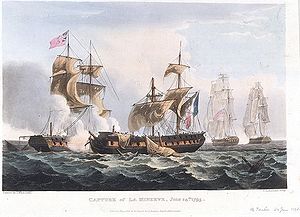 Capture of La Minerve off Toulon, June 24th, 1795 by Thomas Whitcombe. In the foreground the damaged and dismasted Minerve duels with HMS Dido, while in the background Lowestoffe pursues a fleeing Artémise.
| |
| History | |
|---|---|
| Name | HMS Lowestoffe |
| Ordered | 15 February 1760 |
| Builder | Thomas West, Deptford Dockyard |
| Laid down | 9 May 1760 |
| Launched | 5 June 1761 |
| Completed | 1 August 1761 |
| Honours and awards | Naval General Service Medal with clasp "Lowestoffe 24 June 1795"[1] |
| Fate | Wrecked on 11 August 1801 |
| General characteristics | |
| Class and type | 32-gun fifth-rate frigate |
| Tons burthen | 71716⁄94 (bm) |
| Length |
|
| Beam | 35 ft 3+3⁄4 in (10.8 m) |
| Draught | 9 ft 4 in (2.8 m) |
| Depth of hold | 12 ft 6 in (3.8 m) |
| Sail plan | Full-rigged ship |
| Complement | 220 |
| Armament |
|
HMS Lowestoffe was a 32-gun fifth-rate frigate of the Royal Navy. Built during the latter part of the Seven Years' War, she went on to see action in the American War of Independence and the French Revolutionary War, and served often in the Caribbean. A young Horatio Nelson served aboard her shortly after passing his lieutenant's examination.
Originally commissioned near the end of the Seven Years' War, Lowestoffe patrolled in British waters until 1773, when it underwent repairs. She was recommissioned in 1777 and served throughout the American War of Independence, including at the Battle of San Fernando de Omoa. After the bulk of the fighting ended, she returned home to Portsmouth in 1782, and did not see battle for the next decade. She spent most of her later years in British and Mediterranean waters, winning particular glory for her part in an engagement with two French frigates in 1795. Her final duties were back in the familiar waters of the West Indies, where she was wrecked in 1801 while escorting a convoy in the Caicos Islands.
- ^ "No. 20939". The London Gazette. 26 January 1849. p. 237.
© MMXXIII Rich X Search. We shall prevail. All rights reserved. Rich X Search
